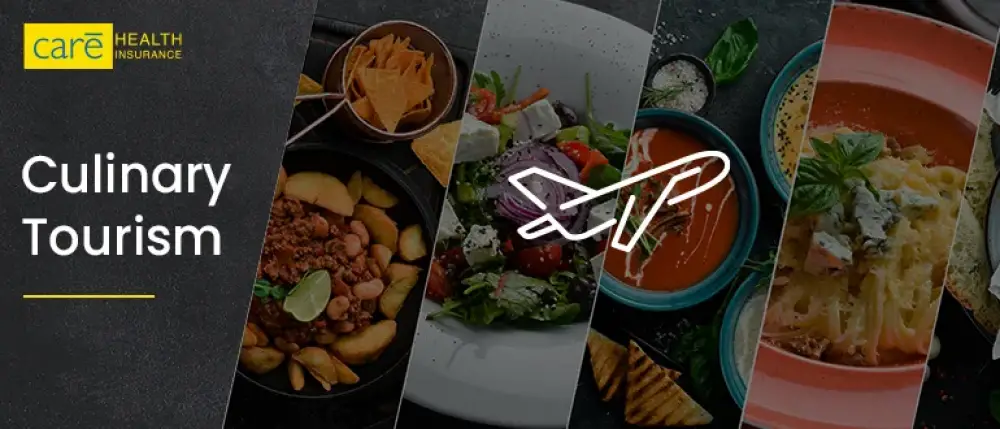Subscribe to get weekly insights
Always stay up to date with our newest articles sent direct to your inbox
Published on 6 Sep, 2024
Updated on 6 Sep, 2024
920 Views
3 min Read

Written by Mudit Handa
favorite0Like
favoriteBe the First to Like
When people travel, they often seek more than tourist attractions and souvenirs. Today travellers like to try the local flavours and cuisines of a destination. Many people now plan their travels to experience the culinary culture of a place. This is called culinary tourism. Food plays a significant role in reflecting the history and culture of a place. It serves as a medium for exploring and understanding the unique cultural heritage through the experience of taste.
In this blog, we will explore the concept of food tourism and discover some popular destinations worldwide. Let's Begin!
Culinary or gastronomic tourism involves travelling specifically to experience local cuisines and food. Travellers participate in activities beyond dining, such as visiting the market to explore local ingredients, attending cooking classes, learning traditional recipes, and buying local produce.
Food enthusiasts love to peek into regional kitchens. Hosts also curate menus to provide an exclusive dining experience to guests. Local chefs design dining experiences with authentic and relevant menus and visit the region’s hidden food gems. Such experiences are pre-booked by travellers who plan trips to taste food and become a part of the local culinary culture.
Through culinary tourism, travellers can taste different cuisines. They are introduced to the cultural and traditional aspects of food consumption such as how to eat, when to eat and the reason for eating a particular food. Travellers learn in detail the idea behind the local food of a region. Let us have a look at the benefits of culinary tourism.
Consuming locally grown traditional food from a region is a dining experience and a cultural experience that helps people understand the local customs, values, and history associated with a place.
Culinary tourism contributes to the growth of local businesses and plays a crucial role in boosting the local economy by creating demand for local foods, beverages, and produce by showcasing and celebrating the offerings of local producers and small-scale industries.
Culinary tourism actively promotes seasonal foods, traditional cooking methods, and sustainable agricultural practices that are environmentally friendly and have a low carbon footprint.
Food is known to bring people together, and culinary tourism can act as a medium for connecting different cultures. Interactions between the travellers and local chefs, vendors, and the local public promote cross-cultural connections.
The importance of culinary tourism lies in the experience it offers travellers and its contribution to the local culture.:
Culinary tourism involves experiences centring around food or a connection between food and culture. Here are some examples of activities you can consider as culinary tour examples.
These are tours of street markets and specialty restaurants. These activities are based on themes such as street foods, exotic foods, and typical drinks.
In such sessions, travellers are given food and drink samples as part of a guided tour. Tasting sessions are mainly conducted for wines and beverages.
Such festivals showcase foods that are part of a region’s history and culture so that travellers learn about the local heritage. Many travellers plan their trips around food festivals organised in a city.
These workshops teach the region’s traditional recipes and cooking techniques. Hotels, cooking classes, and chefs organise such courses.
Here are top culinary destinations which are famous worldwide for their food.
Italy has often been rated one of the best places for foodies. Tuscany is famous for wine and fine dining. Bologna is called Italy's culinary capital. Although it does not attract many tourists, it is a must-visit place for food lovers.
If you enjoy sushi, ramen and tempura, you should visit Tokyo for a culinary experience. Tokyo is a top food destination for food lovers, with over 200 Michelin-starred restaurants.
Lyon is famous as the ‘Gastronomic Capital of the World’. It is renowned for its wine tours and unique traditional cuisine.
Lima has been awarded Best Culinary Destination for years. The diverse population from different cultures has influenced the flavours of the food. Ceviche is known as Lima's dish.
Known as the ‘Street Food Capital of the World’, Bangkok offers a variety of Thai street food readily available. You can also try new tastes at the floating market.
Also Read: Best Place for Rock Climbing in the World
For travellers who want to experience various flavours and cuisines, culinary tourism provides an experience that is much more than food and taste. It is about a cultural exploration through a place's cuisine and local food.
Are you ready for culinary adventures and exploring new food destinations? Do some research to find the perfect place that suits your palate. Once you've found your dream destination, remember to secure your trip with travel insurance from Care Health Insurance. Our international travel insurance plans offer comprehensive coverage for all your travel needs. Contact our experts today and discover the perfect plan that meets your requirements!
Disclaimer: Plan features, benefits, coverage, and claims underwriting are subject to policy terms and conditions. Kindly refer to the brochure, sales prospectus, and policy documents carefully.
favoriteBe the First to Like
List of 10 Countries Where the Indian Rupee is Stronger Care Health Insurance in Travel Insurance Articles
इंडिया से दुबई जाने का खर्चा क्या है? जानें, वीजा से जुड़ी जरूरी बातें Vipul Tiwary in Travel Tips
How to Find File Number in Passport - A Step-by-Step Guide Care Health Insurance in Passport
What Is Non-ECR Category In Passport? How to Apply in 4 Easy Steps? Mudit Handa in Passport
Music Tourism: Transforming International Tourism Mudit Handa in Travel Tips
Always stay up to date with our newest articles sent direct to your inbox
Loading...